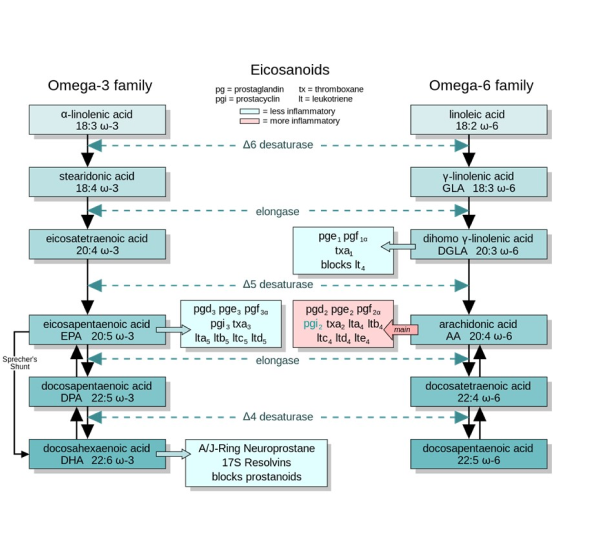Several studies have shown that the fatty acid profile of circulating blood lipids reflects your dietary fat intake and, in turn, it is related to your health status [23, 24, 25, 26, 27]. The fats present in your blood reflect the types of fats your body has available to make energy and to develop cells, including cell membranes, as well as tissues.
The dietary essential fatty acids Omega-6 Linoleic acid (LA) and Omega-3 Alpha-linolenic acid (ALA) must come from the diet as the body itself is not able to produce them.
The dietary essential Omega-6 Linoleic acid (LA) is converted in the body to Omega-6 Arachidonic acid (AA).
The dietary essential Omega-3 Alpha-linolenic acid (ALA) is converted in the body to Omega-3 Eicosapentaenoic acid (EPA) and Omega-3 Docosahexaenoic acid (DHA), as shown in Figure 1. Below.
However, ALA from vegetable sources is not sufficiently converted to marine EPA and DHA in the body. Therefore, EPA and DHA must be provided by direct intake of products from marine sources.
Omega-6 and Omega-3 fatty acids are stored in cell membranes.
When Omega-6 and Omega-3 fatty acids, such as Omega-6 Arachidonic acid (AA), Omega-3 Eicosapentaenoic acid (EPA) and Omega-3 Docosahexaenoic acid (DHA) are released from cell membranes, they are converted into powerful local “hormones”. These local “hormones” control inflammation and smooth muscle contraction throughout the body. It is the production of these local “hormones” from their precursor fatty acids AA, EPA and DHA that determines whether your diet is pro-inflammatory or anti-inflammatory. Long-term pro-inflammatory diet can be devastating to your health.
The good heart health of Greenland Eskimos led scientists to suspect that high fish consumption might be protective [28]. A 20-year study of 852 middle-aged Dutch men consuming at least 30 grams of fish per week showed they had good heart health, compared with men who did not eat fish [29]. A 30-year study of over 2,100 Chicago men who ate at least 35 grams of fish daily also showed they had good heart health, compared to those who ate none [30]. One of the most important effects of marine Omega-3’s EPA and DHA from fish on heart health is their ability to inhibit ventricular fibrillation and consequent cardiac arrest in primary and secondary prevention [31].

Figure 1. The metabolism of Omega-6 Linoleic acid (LA) to Omega-6 Arachidonic acid (AA) and vegetable Omega-3 Alpha-linolenic acid (ALA) to marine Omega-3 EPA and DHA